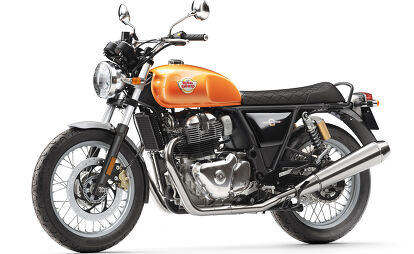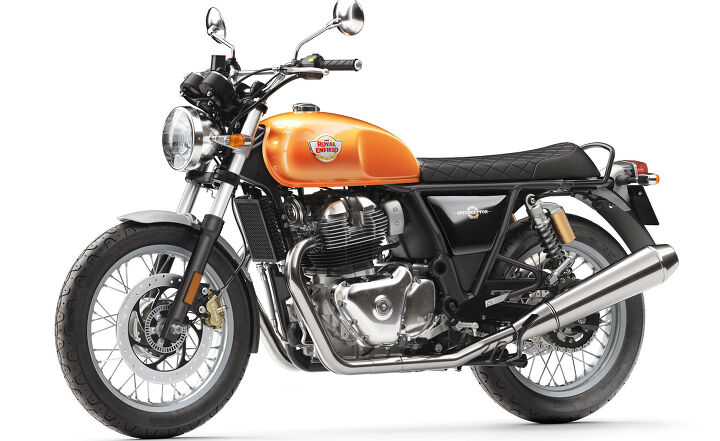Interview: Rod Copes, President Of Royal Enfield North America

Royal Enfield has been on a roll lately. First, the manufacturer has a new engine to broaden its offerings, particularly in the U.S. market where the additional displacement makes for a more viable highway machine. Powered by the new 648 Twin, two new models will hit showrooms in 2018. Both the Interceptor 650 and the Continental GT 650 will be introduced in the coming months, and we’re anxious to throw a leg over them and see what this new engine brings to the table. Then there’s the adventure-focused Himalayan, which is based around a new 411cc single-cylinder engine and stands in between the lightweight and middle-weight offerings from other manufacturers.
2018 Royal Enfield Himalayan Preview
EICMA 2017: Royal Enfield 648 Twin Revealed
Royal Enfield’s UK Technology Center Tour
We recently had the opportunity to sit down with Rod Copes, President of Royal Enfield North America, to discuss what we can look for in the upcoming model year.
MO: We’re anxious to see where Royal Enfield is going in 2018. The new engine and bike models are exciting. What’s do you have planned for us in the next year?
Rod Copes: We’re finishing up phase one of our business in the U.S., establishing a team to get the infrastructure and dealer network. We’ve been focusing on that, preparing for when we get the proper new motorcycles. We’re on the cusp of that. 2018 is going to be a very exciting year with three new motorcycles for us in the U.S. that really match the consumer riding habits.
The Himalayan with the brand-new engine and chassis is going to be great, at a nice price point at $4,500, and the new Twins, the parallel-Twins, the Interceptor and the GT, that are going to be highway-worthy and really a nice value at under $7,000. We are incredibly excited to really start getting our brand awareness out there. The beauty is that we have authenticity with the history and the story of Royal Enfield which goes back to 1901. Next year’s going to be all about getting the story out and getting the brand out – with some great new motorcycles.
MO: Did you meet all your goals with making the dealer network? Or did you find you were more accepted in different areas of the country?
RC: I think we had over-ambitious plans initially, but we’ve only had about two years and we have 70 dealers. All things considered, that’s not too bad. We want to get to 100-120, whatever the right number is. We are adding two to three every month now, so we’ve gotten down to a process that’s really good. I’ll also say that the dealers we’re getting today are much better, on average, than the dealers we were getting a year ago. So, the brand is out there. Now, the bigger dealers are getting more interested in us. That’s kind of our approach. We go into a metro market, and we look for the best multi-line dealer. We don’t care what brands they’re selling; they’re the best. Now, they’re having good conversations with us, and we’re getting many of them to join up.
MO: Over the next few months, as the new motorcycles trickle in, what do see happening?
RC: We’ll be busy, starting with [the IMS tour], revealing the bikes in the United States. We’ll have a press launch ride for the Himalayan in March, and then shortly after that, they’ll be available for sale. We also have running in parallel, our parallel-Twin motorcycles, and we believe our global press launch will be in the United States in Southern California. The Interceptor, back in the early ’60s, was built purposefully for this California lifestyle. So, this is the proper place to do that global launch in an April/May kind of timeframe. Then we will be doing our North America launch sometime after that, probably in the summer when product is available for sale.
Those launches are going to consume a lot of our time and a lot of our effort, getting our brand out there. In the meantime, the current product has some really cool and exciting color, trim, and graphic changes that are coming. For 2018, everything is going to be new. We’ll continue building our dealer network, but then it will be more about getting people on our motorcycles and really telling the story so that people truly understand the authenticity of our brand.
MO: Where to you think this will end up taking you over the next couple years?
RC: Ultimately, what we’re trying to do is – and I think we’re already there – be the global leader in the middle-weight segment. We’re 100%, solely focused on the middle-weight segment, and we have several new platforms of products that will be coming out over the next 3-5 years. So, this is just the start, but what we really want to do is re-energize the middle-weight segment, and the beauty of it is that we can do it in mature markets like the U.S. as well as emerging markets like India. The product hits both.
In India, it’s where all those millions of people want to go to the next product up, and for the U.S., it’s reintroducing middle-weight segment for people that want to come down but moreso to create that next generation of riders that everybody needs. So, it’s working with all manufacturers to create that next generation of riders. We think that, with our light, nimble, easy, fun, and affordable motorcycles, we can play a big role in that. That’s really what our focus is, right now.
MO: What else do you feel our readers should know?
RC: We’re the oldest motorcycle brand and company in the world. We’re the fastest growing. We’re the largest middle-weight, and we’re investing a ton of money in our global capabilities. We’ve got the new technology center in the U.K. and a new technology center being developed in India. We’ve commissioned our third manufacturing plant in India. It’s all world-class capability. The company is sparing no cost to essentially gain the capabilities to be a global player in very short order. If you look at 2010, we produced 50,000 motorcycles. This year, we’ll produce 800,000 motorcycles. A sixteen-fold increase in seven years. That’s the pace that we’re at.
It’s an incredibly exciting company to be part of. They’re very serious and really long-term focused. They understand that in a mature market, like the U.S., this is a 10-20 year venture, and they’re okay with that. We’re having fun. We’re helping the India-based company become more global. So, we’re privileged and honored to be working with them.

Like most of the best happenings in his life, Evans stumbled into his motojournalism career. While on his way to a planned life in academia, he applied for a job at a motorcycle magazine, thinking he’d get the opportunity to write some freelance articles. Instead, he was offered a full-time job in which he discovered he could actually get paid to ride other people’s motorcycles – and he’s never looked back. Over the 25 years he’s been in the motorcycle industry, Evans has written two books, 101 Sportbike Performance Projects and How to Modify Your Metric Cruiser, and has ridden just about every production motorcycle manufactured. Evans has a deep love of motorcycles and believes they are a force for good in the world.
More by Evans Brasfield




































Comments
Join the conversation
Quality is going to be key. It seems to me that with the move from the old factory to the new manufacturing complex, the basic RE quality went up in terms of the engine. I have both a 2009 and a 2014 model single and the new one has an almost Japanese feel to the gearbox, reflecting I believe, closer manufacturing tolerances as a result of new machinery. However the ancillary components, bought in, like wiring harness are still pretty second rate. With 300 miles I had an issue with a brake caliper on my 2014 GT and a fuel pump relay failure at 1000 miles. Quality will make or break this brand and the competition, both in terms of price and quality are tough.
I hope they'll be demoing at Bike Week in March, I'll be interested in checking them out.